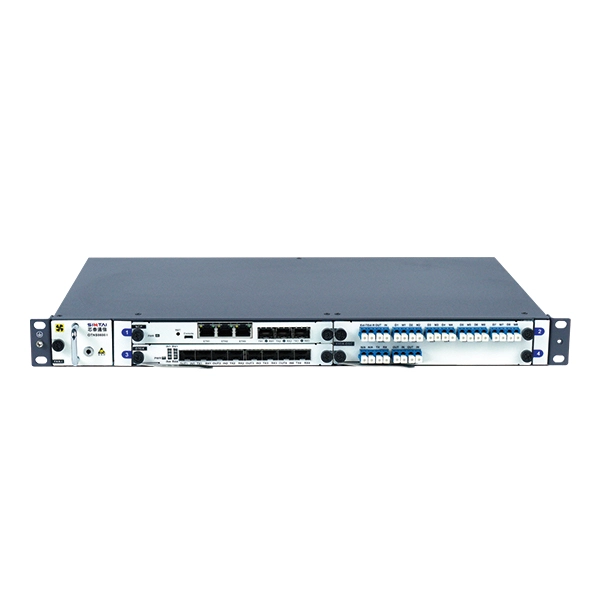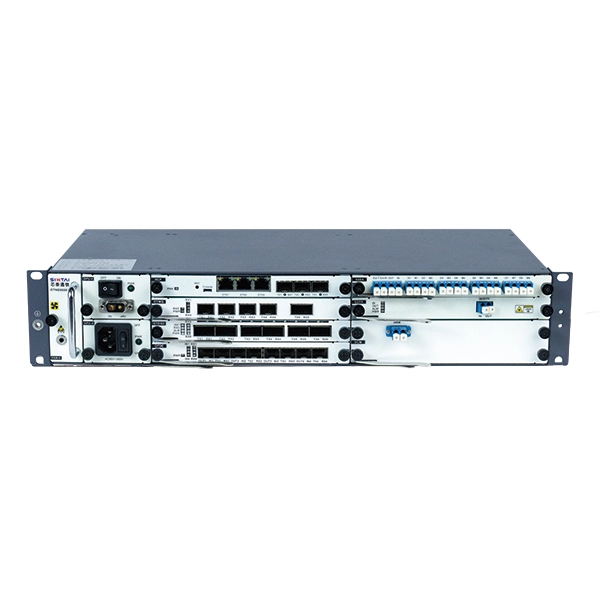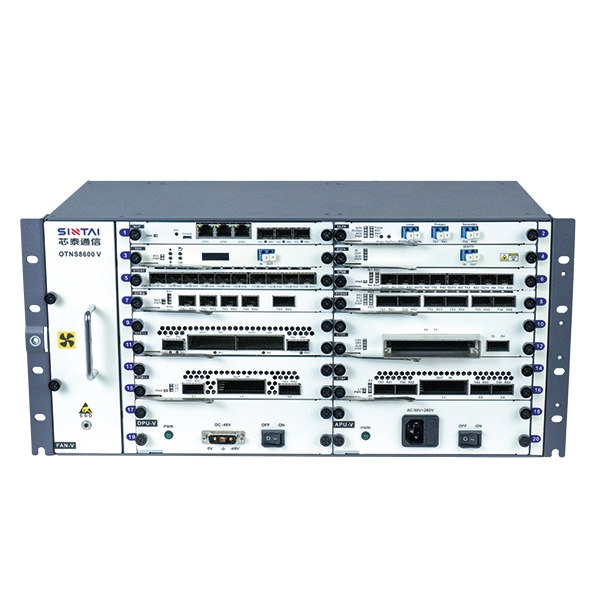SINTAI DWDM/CWDM platform consists of optional 1U (OTNS8600 I), 2U (OTNS8600 II), 5U (OTNS8600 V) chassis for WDM systems, providing a powerful platform for any type of optical networking application.



Multiplexing optical signals of different wavelengths into the same optical fiber for transmission, we call the method or technology wavelength division multiplexing (WDM).

Wavelength division multiplexing (WDM) is a technology that combines two or more optical carrier signals of different wavelengths at the transmitting end through a multiplexer, namely a type of wdm equipment, and coupling them to the same optical fiber for transmission; at the receiving end, the optical carriers of various wavelengths are separated by the demultiplexer, and then further processed by the optical receiver to restore the original signal. This technology of simultaneously transmitting two or more optical signals of different wavelengths in the same optical fiber is called wavelength division multiplexing.
Classification of wavelength division multiplexing (WDM) system
Opening system: Generally, WDM systems have (Optical Transponder Unit) OTU to convert optical signals of non-standard wavelengths of client equipment into optical signals with standard wavelengths that comply with ITU-T G.694.1 or ITU-T G.694.2 recommendations.

Integrated system: Another WDM system does not require OTU. The optical port of the client-side equipment (such as a switch) can be equipped with a standard wavelength division optical module, and the luminous signal of the client-side equipment is directly connected to the multiplexing and demultiplexing unit (MDU) of the WDM system.

Coarse Wavelength Division Multiplexer (CWDM) is a low-cost WDM transmission technology for the access layer of the metropolitan area network. Dense Wavelength Division Multiplexing (DWDM) is to combine a group of optical wavelengths and use a single optical fiber for transmission.
DWDM laser technology is more expensive than CWDM, as it requires more stable wavelength sources. The increasing cost of the DWDM transmitter is mainly due to the high cost of the laser diodes, and the feedback cooling operation to maintain the wavelength stability. And that's the reason why the price of WDM devices vary.
CWDM | DWDM |
Wide wavelength intervals (20nm) | Dense wavelength intervals (0.4nm or 0.8nm) |
Small number of channels (16 channels) | Large number of channels (96 channels ) |
Technical requirement is low | Technical requirement is high |
Mainly used in the access network of the metropolitan area network | Mainly used on trunk lines, in local networks and metropolitan area networks |
Transmission rate is relatively low, and the system capacity is not large | Transmission rate is high and the system capacity is large |
1. Dense wavelength division multiplexers (DWDM) :
DWDM, which stands for dense wavelength division multiplexing, is a technique for sending multiple strands of data over a single network link. At the transmitter, an optical multiplexer brings together two or more optical signals of different wavelengths.
At the receiver, optical demultiplexers are used to separate the signal, which inevitably causes signal loss, but it can be mitigated by optical amplifiers.
Thus, DWDM connections can be used to transmit data over long distances because it can increase the bandwidth of existing fiber networks.

2. Optical transport network (OTN) :
OTN stands for Optical Transport Network and provides a network framework that adds SONET/ SDH capabilities to WDM devices such as performance monitoring, fault detection, communication channels, and multiplexing structure .
It works in layer 1 and brings various tasks together into the tunnel of WDM technology, increasing the transmission distance and capacity of the optical fiber.
This means that OTN frame architecture combines the flexibility of SDH/SONET technology with the bandwidth scalability of DWDM to provide delivery, multiplexing, routing, management, regulation and survivability of optical channels carrying customer signals.
Optical transport networks are designed to provide a transparent framework to efficiently carry different traffic types, which can reduce ACPEX/OPEX in the network while addressing sharp changes in traffic types.
In short, the allure of OTN can be translated into two words: transparency and manageability.
3. Differences between DWDM and OTN
DWDM is a point-to-point system, while OTN consists of an optical crossover connector (OXC) and an optical split-and-insert multiplexer (OADM) with features such as optical crossover capability and wavelength conversion. Developed on the basis of DWDM technology, OTN aims to optimize existing transportation network resources. In addition to providing large capacity DWDM transmission, OTN also allows switching different DWDM channels according to traffic needs.
In addition, because it has been proved to use fiber optic cable and extract the data stream, so people pay more attention to the data on the DWDM link security, by contrast, otns channelizing link and effective will flow into a dedicated circuit with a high degree of privacy and security, can prevent some parts into the network hackers to intercept the data or access to other areas.
It can be seen that OTN networks outperform DWDM networks in terms of enhanced OAM, security and wavelength networking capabilities, standard multiplexing hierarchies, and end-to-end optical transmission transparency for customer traffic.
conclusion
DWDM and OTN are the topics discussed in this paper and are of interest to those who want to make better use of them and deserve further exploration. While there are indeed differences between OTN and DWDM, these two technologies are irreplaceable and have become key points in the telecommunications infrastructure of regional networks by allowing bandwidth to exceed existing networks.
Deliver any service, any protocol, any card with speed. Eliminate networking headaches with solutions that are simple to deploy and operate with future-ready architectures.
As long as the number of multiplexing optical channels and devices is increased, the transmission capacity of the system can be increased to achieve expansion, and the expansion will not have adverse effects on other multiplexing optical paths. Therefore, the upgrade and expansion of the WDM system are smooth, convenient, and easy, so as to maximize the protection of the initial construction investment.
The multiplexing channels of the WDM system are independent of each other, so each channel can transparently transmit different service signals, such as voice, data, and image, which will not interfere with each other. It can bring great convenience to users.
The transmission capacity of the WDM system is very large. Because the multiplexing optical channel rate of WDM system can be 10, 25, 100, 200 Gbit/s, and the number of multiplexing optical channels can be 4, 8, 16, 32, or even more, the transmission capacity of the system can reach as much as 19.2 Gbit/s.
Dense Wavelength Division Multiplexing (DWDM) is an optical multiplexing technology used to increase bandwidth over existing fiber networks. DWDM works by combining and transmitting multiple signals simultaneously at different wavelengths on the same fiber.
CWDM has a wider channel spacing than DWDM. CWDM systems can carry 18 channels. DWDM systems, on the other hand, can carry 40, 80, 96 wavelengths by utilizing a much narrower spacing of 0.8/0.4 nm (100 GHz/50 GHz grid).
DWDM (dense wavelength division multiplexing) is the technology for projecting multiple lambda circuits on fiber strands. Currently, 96 lambdas per fiber is common.
WDM transport system includes CWDM and DWDM, which can achieve large-capacity transmission in a single fiber.